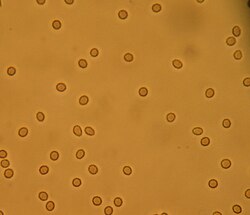
Microhematuria, also called microscopic hematuria (both usually abbreviated as MH), is a medical condition in which urine contains small amounts of blood; the blood quantity is too low to change the color of the urine (otherwise, it is known as gross hematuria). While not dangerous in itself, it may be a symptom of kidney disease, such as IgA nephropathy or sickle cell trait, [1] or bladder pathology which should be monitored by a doctor.
Contents
The American Urological Association (AUA) recommends a definition of microscopic hematuria as three or more red blood cells per high-power microscopic field in urinary sediment from two of three properly collected urinalysis specimens. [2]
Microhematuria is usually asymptomatic, and as of 2001 there were medical guidelines on how to handle asymptomatic microhematuria (AMH) so as to avoid problems such as overtreatment or misdiagnosis. [2] In 2025, American Urological Association guidelines for microhematuria were updated. [3]